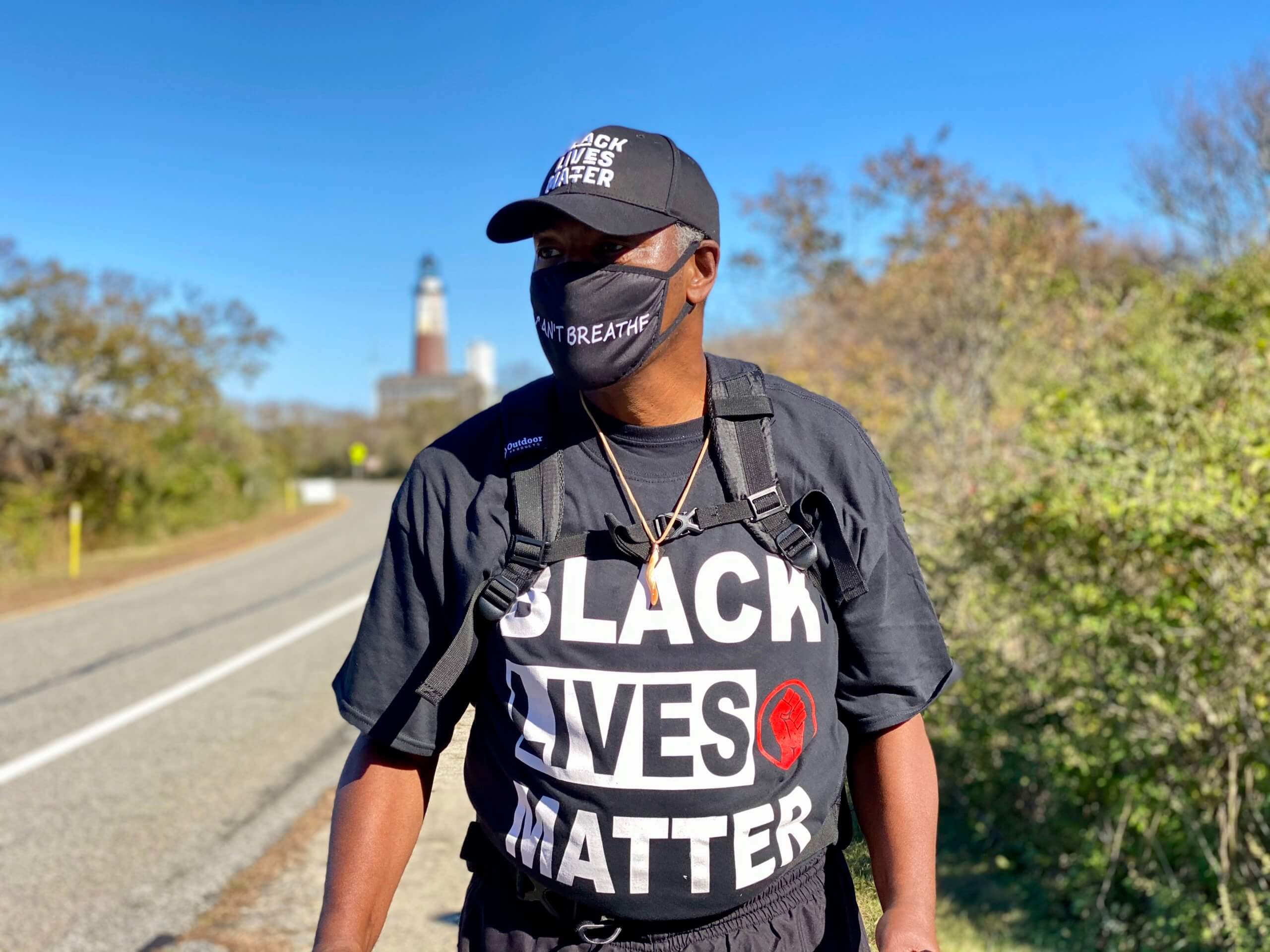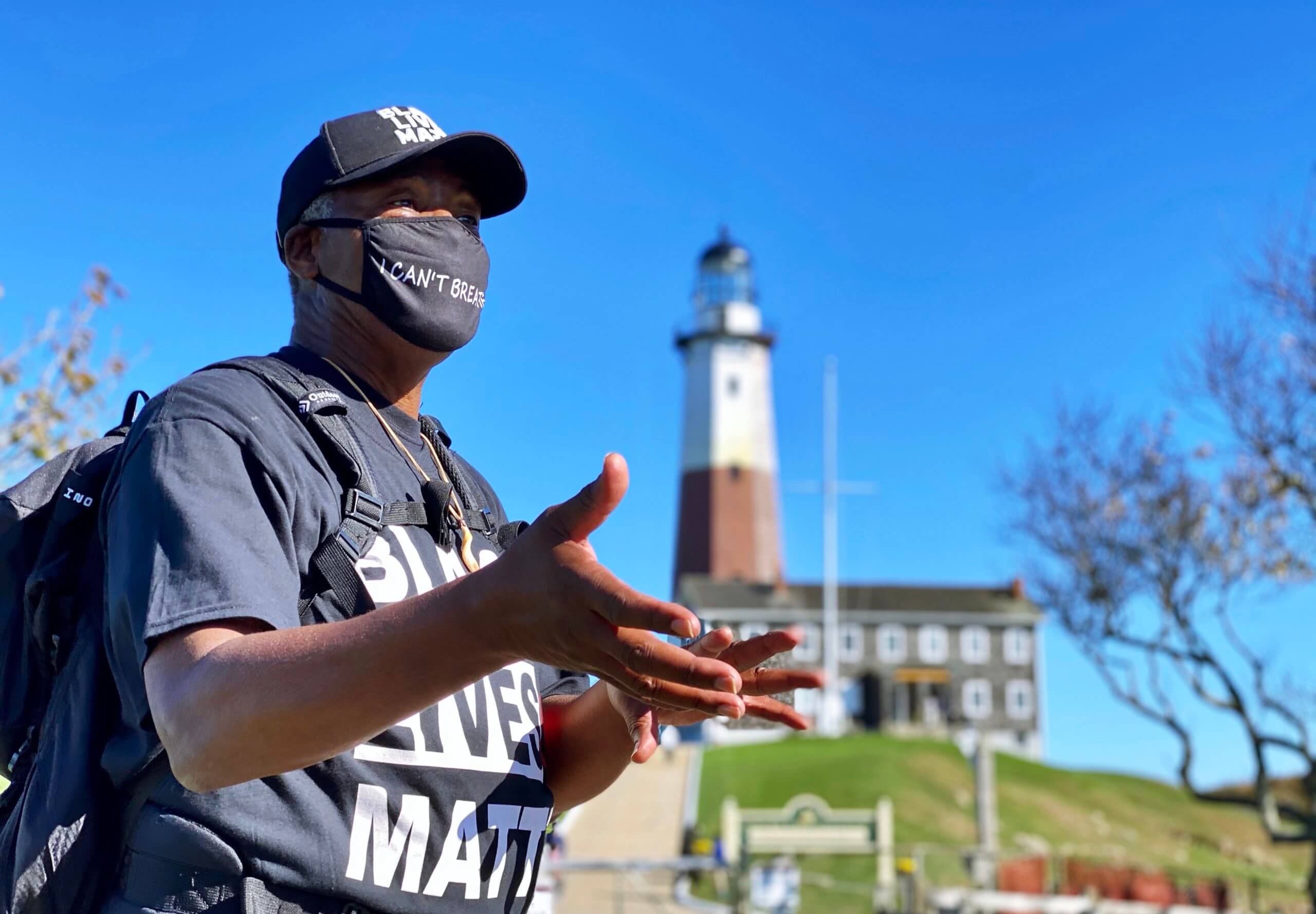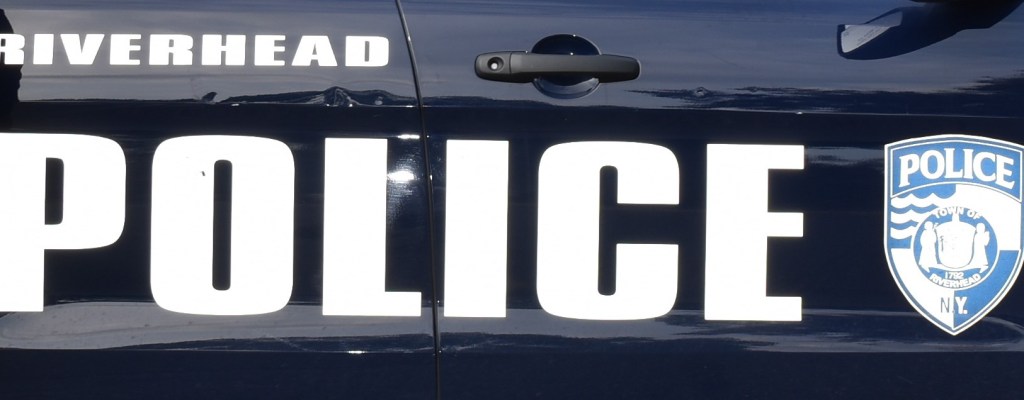Leon Goodman Completes 137-Mile Protest March to Montauk

“Black Live Matter.” For some, this is a statement of support for a group of people who’ve systematically been treated as less than equal and an acknowledgement that our country needs to hold police officers to a higher standard of accountability. For others, these are fighting words, fake news that is turning citizens against their protectors and glorifying perceived acts of violent protest. The noise surrounding the matter has become too much, drowning out the message at the core of the demonstrations honoring the lives of Tamir Rice, Breonna Taylor, George Floyd and many other African Americans killed by cops with little consequences. Bay Shore resident Leon Goodman felt compelled to cut through the static with a demonstration that was big, but not loud—a silent march from the 59th Street Bridge in New York City to Montauk Lighthouse, a 137-mile journey completed on Saturday, October 17.
“I had been watching all the demonstrations across the country, and what I noticed is that the noise of the spin was overshadowing the purposes of the demonstrations. For instance, most of the coverage had to do with stores being burned, clashes with the police; and no one was paying attention to the original message—and that is about acts of police brutality,” Goodman says. “I knew I was doing it for my grandchildren and my great grandchildren and even for me… I was walking so that they would not have to either endure or still have to address these issues as they move on with their lives.”
Goodman, who grew up in segregated Virginia and has experienced racial profiling firsthand, is quick to clarify that there is a critical difference between being anti-police and anti-police brutality, of which he is the latter. While he does support the need for police, he challenges fellow supporters to consider whether or not we should support each and every police officer regardless of actions they may take that break their oath to serve and protect. “My position is that every police department across this country, including those here in Nassau and Suffolk County, must police their own. If there are police officers who are disrespecting the badge and other officers, sullying the name that is not consistent with the oath they’ve taken to become police officers, then they don’t need to be on the force. It’s as simple as that.”
A retired human resources professional of 30 years who most recently worked for the MTA, Goodman knew he’d need to have a plan in place to complete the daunting journey to Montauk at nearly 70 years old. For four days he practiced walking 6.5 miles roundtrip to Bay Shore Marina. He mapped out each day’s march to about 12 miles, concluding at train station where he could use his MTA retiree pass to catch the train back to Bay Shore to rest up for the next day. And he called the Nassau and Suffolk police departments to confirm where he was allowed to walk and other regulations. “I felt it was important to let them know I was doing this, that way no one was surprised if five, six, eight or, during the last five and a half miles, 13 people decided to walk with me,” he says, adding that the county departments went a step further to aid his journey, spreading the word to the local departments to let them know he was coming.
When Goodman embarked on his daunting journey on October 1, his feelings were mixed. “When I left the 59th Street Bridge and I was walking down Queens Boulevard, I had a good angel on my right shoulder and a little devil on my left shoulder. The good angel was saying to me, ‘You are so powerful! You can do this! This is such the right thing to do!’ And the little devil was saying to me, ‘Are you out your damn mind!? Do you know you’re 69 years old? This is the stupidest thing I ever heard!'” Nevertheless, he pressed on.
From the city through Mastic-Shirley, Goodman walked alone—no picket sign, no megaphone, no spectacle. Whenever his Black Lives Matter shirt and hat compelled a passerby to speak up, positively or negatively, he would engage them in friendly conversation, sharing his message while trying to understand their perspective. In one instance, Goodman explained to a young man triggered by his BLM shirt that the issue is not Black lives versus the lives of police officers, and he gave the example of Jonathan Price, who very much backed the blue, but was still fatally shot by a police officer in October. “There’s a little piece of me inside that says what I said to him struck a nerve, and just to prove me wrong, maybe he went home and pulled up what I said on Google just to see if I was lying,” Goodman says. “Maybe I’m being a little too optimistic, but at 69 years old, I know people can change.”

By the time he reached Suffolk, word of his march had spread across Facebook thanks to his daily update videos and photos, and many East Enders either awaited his arrival with uplifting signs and greetings, as did the people of the Shinnecock Nation and Amagansett, or chose to walk alongside him for a short duration of the journey, as did Southampton Town Supervisor Jay Schneiderman and several locals. “Can you imagine this? I’m this guy from Bay Shore who doesn’t know anyone past Bay Shore, for all intents and purposes, and all of a sudden, these people are coming and saying, ‘We just want to walk with you, because we think what you’re doing is important,'” he says of his meeting with local couple Anita Boyer and Joe Pallister, who joined him in Hampton Bays.
“I’m just a white guy working to check my privilege and do whatever I can to support and listen to my brothers and sisters of color,” Pallister says. “Walking with Leon was incredibly humbling, and it was an honor to be there to support him. He is an inspiration even though he was adamant that the walk was not about him, it was about the cause—to end police brutality.”
On the second-to-last day of his arduous journey—when he trudged through the rain on an extra-long 17-mile portion of the walk, up the hill that leads to Montauk—he had the faintest doubt that he’d be unable to complete his journey. “That’s when a little doubt set in, but I had committed to myself that I was doing this, so I did it,” he says. “[The next day] when I rounded the curve just before I got to the Montauk Lighthouse, I guess the word had gotten around that I walked all these miles to get there, and there were so many—at least 50 to 75—people standing there applauding and saying thank you.”
Looking back at his 137-mile journey, Goodman feels deeply rewarded to have gotten to speak with the people he met along the way, cherishing both the positive and negative conversations. “Obviously, the positive people that met with me and were in agreement with why I was doing what I was doing, were impactful, but meeting the negative people also gave me an opportunity to communicate what I perceive to be my message,” he says. “When I started this, I wasn’t looking for accolades; I just knew within my heart that I had to do something that was meaningful, and thus the silent protest march. It was important for me to ask the question: Can you hear us, and are you listening? This was about me enduing the physicality of walking those miles so that people would get an opportunity to either communicate with me, challenge me or just look at the fact that I left the 59th Street Bridge determined to walk to Montauk Lighthouse. That, in itself, should strike up some conversation.”



